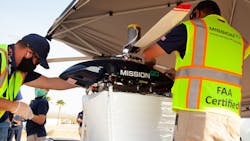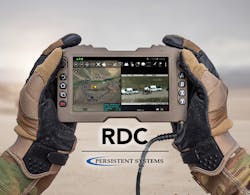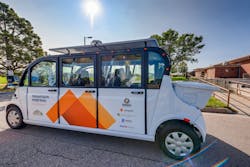Human organ drone delivery test flights successfully completed
In this week’s roundup from the Association for Unmanned Vehicle Systems International, which highlights some of the latest news and headlines in unmanned vehicles and robotics, human organ deliveries via unmanned aerial systems, new handheld drone controllers for military operators, and the United States Army deploys automated ground shuttle service at a base in Colorado, USA.
MissionGO, Nevada Donor Network use UAS to deliver human organ and tissue
On Sept. 17, UAS solutions provider MissionGO and organ procurement organization (OPO) Nevada Donor Network completed two successful test flights carrying a human organ and tissue via UAS.
During the first flight, research corneas were transported from Southern Hills Hospital and Medical Center to Dignity Health - St. Rose Dominican, San Martín Campus. The flight successfully demonstrated the viability, value, efficiency gains, and delivery speed of UAS when used to deliver lifesaving medical supplies and organs within an urban environment.
During the second flight, a research kidney was delivered from an airport to a location outside of a small town in the Las Vegas desert, marking the longest organ delivery flight in UAS history. The flight surpassed the distance of an April 2019 flight when MissionGO team members Anthony Pucciarella and Ryan Henderson, in their roles at the University of Maryland UAS Test Site and in partnership with the University of Maryland Medical Center, delivered the first kidney by UAS that was then successfully transplanted into a patient.
“These flights are an exciting step forward – the research conducted during last week’s test flights are another data point to illustrate that unmanned aircraft are a reliable mode of transportation for life-saving cargo, and that MissionGO’s UAS are safe for both the payload and people on the ground – even at greater distances,” says Anthony Pucciarella, MissionGO President.
“We are grateful to be testing our technology with our partners at the Nevada Donor Network and look forward to what we can achieve together with more research like this.”
Due to limited transplant programs available locally, the majority of organs donated in Las Vegas must currently be shipped to recipients in other states. The second flight test showcased an exciting possibility for the future of organ transportation specifically within the Las Vegas region.
The entities say that using UAS in multimodal transportation chain offers a variety of benefits, including a reduction in the time between organ donation and transplantation, a reduction in the carbon footprint by using electric aircraft, and the potential to expand organ procurement efficiency, which saves more lives. The Nevada aviation research is the beginning of a series of medical and aviation research flights with OPOs in other regions.
“The success of last week’s tests launches us into the future of organ transportation and will enable us to be even more successful in the coming years,” says Joe Ferreira, CEO and president of Nevada Donor Network.
“The work we’re doing now to maximize the gift of life and health can only be amplified with the services that MissionGO demonstrated. The future of organ donation and transplantation will be defined by innovation.”
MissionGO has additional flight tests planned for later this year and throughout 2021 with additional OPO innovation partners across the country.
Persistent Systems unveils new Rugged Display and Controller for MPU5 MANET device
Last week, Persistent Systems unveiled the new Rugged Display and Controller (RDC) for the MPU5 mobile ad hoc networking (MANET) device.
The purpose built RDC is an alternative to third-party consumer Android phones used with the MPU5, offering improved ruggedness, ergonomics, and enterprise-class management in one of the few Android End User Devices (EUD) made in America.
“When you plug in the RDC, you instantly have a complete situational awareness capability,” says Brian Soles, Persistent’s vice president of Business Development.
“The MPU5 is a computer that runs the Android operating system, and every MPU5 comes preinstalled with the Tactical Assault Kit (TAK), which is a full-fledged situational awareness Android app.”
The tactical operator has a complete kit at their disposal with the RDC’s 5.7-inch multi-touch screen, combined with the Dual PTT and MPU5. With this complete kit, the operator can receive voice, video, and situational awareness data directly from every user, unmanned systems, and sensor on the network.
The RDC is designed for tactical users who wear gloves, so it has physical buttons for ease and speed of use, including the Android standard Home, Back, and App Overview buttons. When connected, the RDC appears to Android as a Gamepad Input Device, with two joysticks, rocker-switches, A-B-X-Y buttons, and an emulated D-Pad. Using joysticks to zoom in and hotkeys to quickly switch between functions, tactical users can now navigate their applications faster.
Eight integrated high-precision sensors (accelerometer, gyroscope, magnetometer, thermometer, pressure, light sensors, and rear-facing camera) feed data into the Android Sensor Framework, which enables applications to incorporate motion, orientation, and environmental data.
“We designed the RDC to match the chest-worn formfactor that users were already accustomed to with commercial EUDs, while delivering increased ruggedness and capability,” Soles explains. “We contracted Juggernaut.Case to design the chest mount, to provide a unified experience to the end-user.”
Persistent notes that Wave Relay Ecosystem partners and third parties have developed Android applications to drive unmanned ground robots, fly UAS, and steer EO/IR cameras. Persistent says that the RDC helps achieve its vision to deliver those capabilities to every soldier through the networked battlefield.
US Ignite launches Mountain Express Automated Shuttle at U.S. Army Installation in Colorado
On Tuesday, Sept. 15, US Ignite announced the launch of the Mountain Express Automated Shuttle at Fort Carson, Colorado, a United States Army installation.
An electric vehicle capable of performing all driving functions independently under certain conditions, the Mountain Express will provide passenger service on the post as part of a yearlong effort to test automated vehicle technologies and collect data for future transportation modeling on smart military installations across the country.
“We are excited to debut the Mountain Express shuttle service and see it as an opportunity to extend research on automated vehicles in ways that will benefit both military installations and smart communities pursuing advanced transportation solutions,” says Eric Werner, director of Autonomous Vehicle Programs at US Ignite.
“This project has already progressed rapidly, and we look forward to further developments and research insights now that the shuttle has entered an operational stage.”
In 2019, Fort Carson launched a Smart Transportation Testbed project. US Ignite, a nonprofit, runs the $4 million project, which includes the Mountain Express shuttle. The U.S. Army Engineer Research and Development Center (ERDC) provides funding and management for the project.
The vehicle itself is a Polaris GEM automated shuttle custom-configured by Perrone Robotics using the company’s TO Navigate You (TONY) autonomy kit. Partner company First Transit is in charge of shuttle service operations at Fort Carson.
The Mountain Express began running a three-mile route every weeknight this week at Fort Carson from 5:30 p.m. to 9:30 p.m. For safety purposes, the vehicle has an operator on board at all times with the ability to take over manual controls.
To prevent the spread of the COVID-19 virus, additional safety measures are in place, including a clear barrier installed between rows of seats in the shuttle, and the completion of a full cleaning wipe-down after each shuttle loop. All passengers are required to wear face coverings.
Compiled by Brian Sprowl, Associate Editor, AUVSI
Share your vision-related news by contacting Dennis Scimeca, Associate Editor, Vision Systems Design
SUBSCRIBE TO OUR NEWSLETTERS


